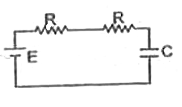The effective resistance of a circuit containing resistances in parallel is
equal to the sum of the individual resistances
smaller than any of the individual resistances
greater than any of the individual resistances
sometimes greater and sometimes smaller than the individual resistances
The correct Answer is:B
To find the effective resistance of a circuit containing resistances in parallel, we can follow these steps:
Step 1: Understand the Concept of Parallel Resistance
In a parallel circuit, the voltage across each resistor is the same, and the total current is the sum of the currents through each resistor. The effective resistance (R_eq) in a parallel circuit is always less than the smallest individual resistance.
Step 2: Use the Formula for Effective Resistance
The formula for calculating the effective resistance (R_eq) of resistors in parallel is given by:
1Req=1R1+1R2+1R3+…
Where R1,R2,R3,… are the individual resistances.
Step 3: Analyze the Options
Given the options:
1. Equal to the sum of the individual resistances
2. Smaller than any of the individual resistances
3. Greater than any of the individual resistances
4. Sometimes greater and sometimes smaller than the individual resistance
Step 4: Evaluate Each Option
- Option 1: This is incorrect because in a parallel combination, the effective resistance is not the sum of the individual resistances; that applies to series combinations.
- Option 2: This is correct. The effective resistance in a parallel circuit is always less than the smallest individual resistance.
- Option 3: This is incorrect because the effective resistance cannot be greater than any of the individual resistances in a parallel circuit.
- Option 4: This is also incorrect because the effective resistance in a parallel circuit is consistently less than the individual resistances, not variable.
Step 5: Conclusion
Thus, the effective resistance of a circuit containing resistances in parallel is always smaller than any of the individual resistances. Therefore, the correct answer is Option 2.
---
In a parallel circuit, the voltage across each resistor is the same, and the total current is the sum of the currents through each resistor. The effective resistance (R_eq) in a parallel circuit is always less than the smallest individual resistance.
The formula for calculating the effective resistance (R_eq) of resistors in parallel is given by:
Given the options:
1. Equal to the sum of the individual resistances
2. Smaller than any of the individual resistances
3. Greater than any of the individual resistances
4. Sometimes greater and sometimes smaller than the individual resistance
- Option 1: This is incorrect because in a parallel combination, the effective resistance is not the sum of the individual resistances; that applies to series combinations.
- Option 2: This is correct. The effective resistance in a parallel circuit is always less than the smallest individual resistance.
Thus, the effective resistance of a circuit containing resistances in parallel is always smaller than any of the individual resistances. Therefore, the correct answer is Option 2.
Topper's Solved these Questions
Similar Questions
Knowledge Check
- Question 1 - Select One
Total resistance of the circuit:
 A10ΩB20ΩC5ΩD15Ω
A10ΩB20ΩC5ΩD15Ω - Question 2 - Select One
The resistance of an open circuit is
AinfinityBzeroCnegativeDcan't be predicted - Question 3 - Select One
The effective resistance of two resistors in parallel is 127Ω. If one of the resistors is disconnected the resistance becomes 4Ω. The resistance of the other resistor is
A4ΩB3ΩC127ΩD712Ω
Resistance In Parallel
View Solution(a) With the help of a suitable circuit diagram peove that the reciprocal of the equivalent
resistance of a group of resistances joined in parallel is equal to the sym of the
reciprocals of the individual resistances.
(b) In an electric circuit two resistors of 12Ω each are joined in parallel to a 6V battery.
Find the current drawn from the battery.View SolutionDrive expression for the total resistance of a circuit in which a few resistors are connected in parallel.
View SolutionA uniform wire of resistance R and length L is cut into four equal parts , each of lengths L/4, which are then connected in parallel combination. The effective resistance of the combination. The effective resistance of the combination will be
View SolutionThe time constant T for the shown circuit containing resistance and capacitor, is
 View Solution
View Solution

